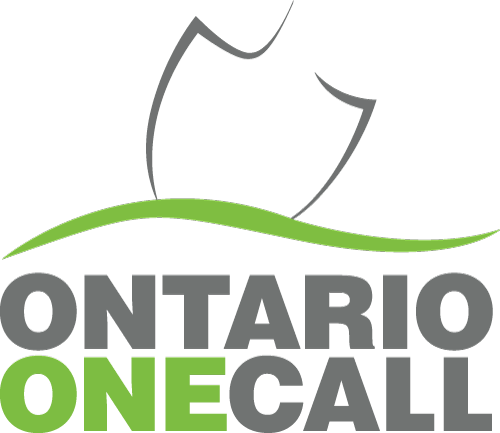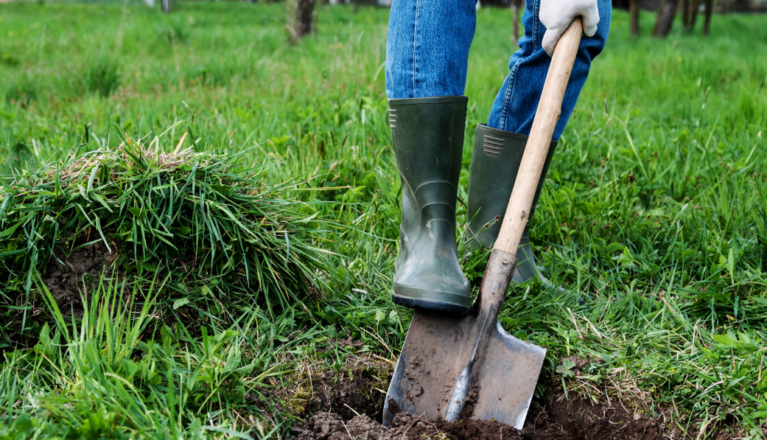Identifying Underground Hazards
Ontario One Call will notify buried infrastructure owners that you plan to dig. Representatives, known as Damage Prevention Technicians or Locators, from each buried infrastructure owner will come out to mark the location of buried underground lines and cables they own so that you can dig safely.
Steps To Request Locates

Contact
At least 5 business days before you dig, submit a locate request. We will notify buried infrastructure owners that you plan to dig

Locate
Locators from each buried infrastructure owner will come out to locate the buried lines & cables

Dig
Dig safely. Respect the marks
and follow the instructions that are provided.
Looking For Help?
Learn how to submit a public utility locate request by watching our How-to videos or searching the public locate FAQs.
Private Locates
While Ontario One Call operates the notification system for buried infrastructure, it’s the responsibility of homeowners to have the following types of infrastructure marked:
- Gas line that goes from a house to a BBQ or pool heater
- Lights or signs on the property
- Electrical lines going out to sheds or a detached garage
- Sewer and septic tanks, systems and piping
- Telecom or electrical lines feeding security cameras
Homeowners, or Contractors on their behalf, MUST submit a locate request through Ontario One Call whether they are excavating on public OR private property.
When you submit a locate request you will be advised to obtain private locates for any privately owned underground infrastructure such as the ones indicated above.
Hiring A Contractor?
If you have hired a contractor, make sure your contractor has contacted Ontario One Call before they start your project. If you are a contractor visit our Contractor page.
How To Cancel A Locate Request
A locate request can only be cancelled before the Work to Begin date that was selected when the locate request was submitted, but not after. This is because the buried infrastructure owners might have already completed the request to meet their requirements under the law.
If you are a homeowner or renter, the only way to cancel a locate request is by calling in to our call centre at 1-800-400-2255.
Contractors are able to cancel their locate request through the web portal.
If the Work to Begin date has passed, a request can NOT be cancelled. In that case, please contact the owners of buried infrastructure directly and let them know that the locate is no longer needed. They will mark it as completed in 360 Feedback with the date which they were notified.
Is There An Unknown Danger Clogging Your Sewer?
Some underground natural gas pipes may have been unintentionally installed through sewer pipes. Although this is rare, recognize the danger and ensure there are no conflicts with underground gas lines. It’s free. It’s easy. It’s safe.
Complaint Process
If you have reasonable grounds to believe there has been a contravention of the Act, its regulations or the by-laws of Ontario One Call, you can submit a complaint.
Frequently Asked Questions
Search homeowner-related FAQs and available resources and best practices.
Ontario One Call is a notification system and does NOT provide, contract, or manage locates. The local Infrastructure Owner companies listed on your locate request (gas, electricity, telecom) are legally bound to provide locates for the infrastructure they own within the legislated timeframe. If they do not, please contact the Infrastructure Owner or the Locate Service Provider first. If you have not achieved results:
- You can file a complaint against the Infrastructure Owner through our webform
Requesting a locate before you dig is free, easy and it’s the law.
There are numerous underground hazards that could cause serious injuries. Hitting gas, electric, or other high-pressure pipes and lines could have fatal consequences. We must all prevent damages to protect our communities.
Never assume it is safe to dig
- Nicking a gas line could lead to leaks, fire, or explosions.
- Damaging electrical cables could shock or electrocute you.
- Hitting water or sewer lines could cause flying debris, floods, contamination, and environmental hazards.
- Cutting telecommunications cables could disrupt internet or cable services and your ability to call 911 in an emergency.
- To dig safely, excavators must first obtain a locate by contacting Ontario One Call, then follow the written instructions provided with each locate response, and follow best practices as outlined in the Canadian Common Ground Association’s (CCGA) Underground Infrastructure Damage Prevention Best Practices.
Anyone not following safe digging practices, and who hits underground infrastructure could be held liable for damages. Charges and fines could also be laid by Ontario One Call, the Ministry of Labour, the Technical Standards and Safety Authority (TSSA), and other regulators.
Despite these penalties, the Ontario Regional Common Ground Alliance’s (ORCGA) DIRT Report found that there were 4,402 reported damages to underground cables, pipes, and lines in 2021. 41% of the damages were caused by improper excavation practices, and 35% were caused because a locate was not requested.
Paint, stakes or flags are some of the various methods buried infrastructure owners field locate where they have underground pipes, wires, or cables. Each type of infrastructure has a unique colour associated with it.
RED
Electric
YELLOW
Gas/Oil/Steam
ORANGE
Communication
GREEN
Sewer/Storm
BLUE
Water
PURPLE
Irrigation/Slurry
PINK
Temporary Survey Markings
WHITE
Proposed Excavation
Remember to dig safely. Follow instructions given by each infrastructure owner. Do not begin a dig until you have confirmed all notified utilities have responded to your locate request.
Pool heater lines and barbecue lines are a great example of “private lines”. Private lines are installed by private contractors (i.e. not utility representatives) and are not covered by Ontario One Call’s Infrastructure Owners. A separate private locate must be arranged for lines of this nature. Learn more about on private locates.
To see all of our locate status definitions download this document.
Private buried infrastructure (including buried infrastructure beyond a utility demarcation point) on private property is the responsibility of the property owner to have marked.
Examples could include:
- Gas line that goes from a house to a BBQ or pool heater
- Lights or signs on the property
- Electrical lines going out to sheds or a detached garage
- Sewer and septic tanks, systems and piping
- Security cameras
This image shows some examples of properties with public infrastructure shown in solid lines and private infrastructure shown in dashed lines.
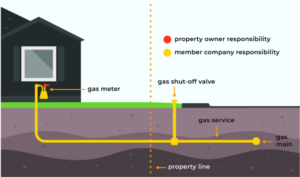
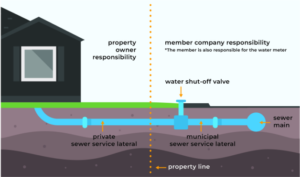
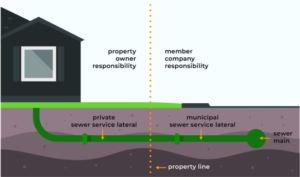
To get your private lines marked, a competent private locator must be hired.
A Suspended Locate Request is when the Ontario One Call system detects something that might be incorrect on a locate request. A suspended locate request will be reviewed by an Ontario One Call agent prior to being released. Once reviewed, the person who submitted the locate will either receive a clarification email to get more information or a confirmation that the locate request will be processed.
The locate validity period is determined by the infrastructure owner. Locates are valid for at least 60 days from the day you receive your locate, but could be longer. The infrastructure owner will clearly identify the length and conditions of the validity period for the locate request. Please check the locate sheet sent to you from the infrastructure owner or their LSP.
Ontario One Call does not complete or schedule physical locates. We transmit your dig information to buried infrastructure owners or the Locate Service Providers (LSP) they authorize.
Once the locate request leaves our office, it becomes the responsibility of these parties. We have no “pull” with infrastructure owners or locators to expedite locates. If you cannot resolve your issue with the infrastructure owner or LSP directly and wish to file a complaint, please reach out to our compliance department via our complaint form.
If you damage any infrastructure, please call the buried infrastructure owner directly. Even a sheath or coating nick can cause corrosion which may lead to a future problem. Leave the excavation open until it has been inspected.
You must follow the instructions provided by each buried infrastructure owner in response to your request. To see an example of a locate sheet, and how to read it, download this resource.
Please review this PDF to see an example of a locate sheet and how to read it.
Excavators request locates for a variety of reasons. Cities dig to repair water and sewer lines or rebuild roads/sidewalks. infrastructure owners dig to repair or upgrade their lines, etc. Please keep in mind that the municipality you live in, technically, “owns” the land up to your property line. If they must excavate on the publicly-owned portion of the property, they may do so without consulting you first. While there is no arguing that you own your private property, the infrastructure buried underneath that property is owned by the respective owner. Please do not remove flags/paint on your property. It is the policy of most companies and certainly a courtesy to notify you of any planned excavation.
Ontario One Call’s Privacy Policy forbids our Representatives from discussing locate requests with anyone but the person who requested the locate, an Ontario One Call member, or a third party investigative body/legal body.
Whether submitted over the phone or through the web portal
- Log in to the web portal using the email address and phone number on your locate request
- Select “Request Search”
- Enter your request number and click the Search button – if your do not know your request number select advanced search to find more options
- Click on the request number that is highlighted in green
- Click on the “Locate Status” to review information and find contact numbers should you need to reach out to follow up on your locate.
To view step by step video please see our how-to video resources.
Please review your request to ensure there are no errors or omissions. Errors or omissions may be corrected by contacting us at 1-800-400-2255. It is your responsibility to ensure that your request is accurate.
The first page of your locate request will be the request confirmation:
A: Request Confirmation. Use this number when obtaining a locate status from Ontario One Call’s 360 Feedback, calling Ontario One Call to inquire about your locate request or calling an Ontario One Call Member about your locate request.
B: Contact Information. Please review to ensure accuracy. This is the information the owners of buried infrastructure will use to contact you.
C: Dig Location. Please review to ensure accuracy. This is the address that will receive the locate. Please be as specific as possible with Dig Location. Ontario One Call prefers that, if possible, you situate your dig site between the two nearest intersecting streets. These would be the two streets that are to your immediate left and right when standing in front of your property.
D: Dig Information. This section tells Ontario One Call what type of work you are doing on the property and where you are doing it. Please be as specific as possible.
E: Members Notified. This section tells you who Ontario One Call notified of your intent to excavate. Review this section thoroughly and ensure that any other infrastructure Owners not mentioned in this section are contacted by you directly.
If there is a “C” beside the Member name, that owner of buried infrastructure has issued you a clearance for your work, meaning you are safe to commence your excavation as far as that Member is concerned (remember there are other owners of buried infrastructure on your request).
The second page of your request confirmation consists of disclaimers and information that is important to note. It is your responsibility to ensure that your request information is accurate. Please review this information thoroughly and contact 1-800-400-2255 if you have any questions.
There is basic, mandatory information Ontario One Call needs to complete your locate request:
1. Your name
2. Your phone number
3. Your email address (kept in a confidential database used only by Ontario One Call affiliates for locate request purposes)
4. The location of the dig site, including City, Address, Dig Street, and the two nearest minor intersecting streets to the property where you are excavating. Please note that our system will provide you with the nearest intersecting street we have available, all that is required is your verification.
5. Type of work occurring on the property
Please clear cookies and cache before requesting a locate to avoid mapping errors.
Additional information that is good to have and may expedite your locates includes:
1. Whether you’re excavating at the front, back, or side of the property and if you are digging near any property lines (i.e. if you are on public property or private property)
2. Whether your property is a corner lot or not
3. What side of the road your property is on (N,S,E,W)
4. Whether you will be digging by hand (shovel, pick or spade), or machine
5. If your type of work is a fence, whether the fence is being placed past the front corners of the house
6. If your type of work is a pool, whether a fence is being installed at the same time
7. Any special information you would normally give to someone visiting your house (ex. if you have a dog in the backyard)
All notified infrastructure owners must respond to your locate request before you are allowed to dig. Infrastructure Owners are required to complete their locates within 5 business days. While the law mandates these deadlines, there is no guarantee a locate will be provided in 5 business days. If an Infrastructure Owner is late, please follow up with them first by using the contact information they provided on the locate confirmation. You can find the contact information within the locate status once you log into the web portal. This how-to-video shows how to find your locate request and the locate status – https://youtu.be/Yv5SpFgoL50.
If the response received from an Infrastructure Owner or locate service provider is unsatisfactory, you can file complaint against the Infrastructure Owner – complaint form.
For Emergency locate requests, the infrastructure owners’ crews have to be on site within 2 hours from the request. Planning and design requests are voluntary, and infrastructure owners who utilize this service do not have a legislated timeframe in which to respond.
Homeowners can still place locates by phone, but contractors need to place their locate request online through our web portal. Click here to request a locate. Locate requests made online are more accurate, and help save time for those providing the locates. For any questions or assistance, please contact our Contractors Support line at 800-400-2255. Please note that our Customer Service Specialists will be happy to answer your questions but won’t be able to place a locate request for you.
Current legislation does not require the participation of First Nations, the Province of Ontario or the Government of Canada to register all their infrastructure, but all other infrastructure that crosses onto a public right of way is required to register with Ontario One Call.
Any privately owned infrastructure will not be notified by Ontario One Call. For example, you may have a gas line that goes from your gas meter to your pool or barbecue, or you may have an electrical line that goes from your house to your garage or you may be on a septic system or well. This would not be covered under an Ontario One Call Request to dig. You may need to contact and hire someone to find these pipes and cables for you. Learn more about private locates.
Once notified, the owner of the buried infrastructure responds back to the person who requested to dig in one of two ways: a clear or a “completed” locate
A clear is when an owner of the buried infrastructure reports that your dig activity has low to no conflict with their infrastructure. This clear may be based on any information you provide to Ontario One Call, so ensure you do not stray outside the plans you’ve provided. There must be paperwork that comes with this “Clear.”
A “completed” locate is when an owner of the buried infrastructure marks on the ground where their infrastructure is located and provides paperwork backing up their markings. In addition, this paperwork will have instructions on how to dig around the marked infrastructure. For example, “Dig by Hand within 1 meter of the markings.”
Sometimes this response is instantaneous, if not, infrastructure owners need to complete their locates or clearances in field.
You must wait until all owners of buried infrastructure notified have responded with the appropriate paperwork and either a clear or a “completed” locate.
When Ontario One Call receives a request to dig, we record the details and provide those details to owners of infrastructure in that area. We call the act of providing them those details “Notification.”
The owners of buried infrastructure will receive the notification from Ontario One Call and respond back to the person requesting the locate. You can review the owners of buried infrastructure notified by checking the bottom of your request. Additionally, with your request number, you can view the status of your locates through our 360 Feedback program.
You must wait until all the notified owners of buried infrastructure have responded before beginning your work.
Ontario One Call connects the owners of buried infrastructure with the people who want to dig across Ontario. Contact Ontario One Call, and when Ontario One Call receives a request to dig, we record the details and provide those details to the owners of infrastructure in that area. We call the act of providing them those details “Notification.”
The owners of buried infrastructure will receive the notification from Ontario One Call and respond back to the person requesting the locate. You can review the owners of buried infrastructure notified by checking the bottom of your request. Additionally, with your request number, you can view the status of your locates through our web portal.
You must wait until all the notified owners of buried infrastructure have responded before beginning your work.
Please note that Ontario One Call reserves the right to refuse locate requests if the information is insufficient, conflicting, or confusing.
The locates are completed by the owners of the buried infrastructure or their respective Locate Service Providers. Ontario One Call does not perform locates.
That depends on who is doing the excavation. If you are doing it, you are responsible for getting a locate first. If you are hiring someone to complete the excavation for you (landscaper, fence company, deck builder, etc.) they should get the locate. The person physically completing the excavation is responsible for obtaining locates, regardless of whose property the excavation is occurring on.
However, keep in mind that if you are hiring someone, even if you are not legally responsible for getting the locate, you should make sure they get one before starting any work.
Requesting a locate through Ontario One Call is free.
